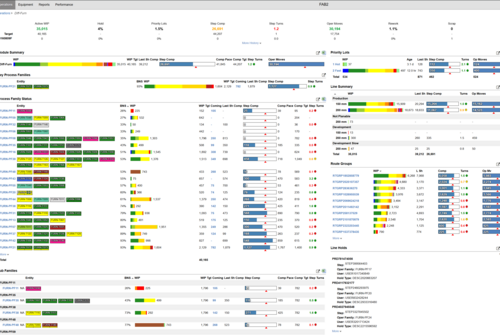Enhanced Cycle Time
Product Introduction and Benefit

For every lot that contributes to cycle time, ECT provides second by second status details for every state transition. Drill down from factory level cycle time all the way to individual sub states to see when product is waiting, on hold, dispatched, blocked, or in process.
ECT is fully integrated with Cycle Time Analyzer (CTA) and provides tools to research both dynamic cycle time and finished lot cycle time.
Key Features
New Cycle Time States Provide Greater Visibility into Blocked and Down Tools
For many years, FPS Dynamic CTA and Finished Lot CTA have provided calculations and visualization of cycle time divided into processing time, waiting time, and hold time. With ECT, cycle time is further divided by the new states Dispatched, Ended, Blocked, and Tools Down.
Dispatched is the time from when the lot is selected/dispatched/tracked in to the tool until it starts processing.
Ended is the time from when the lot ends processing until it is moved/completed/tracked out from the current step to the next step.
Blocked is when the lot is waiting, but all the allowed tools are blocked from running the lot immediately for reasons such as queue timers, reticles, temporary inhibits, etc.
Tools Down is when the lot is waiting, but all of the allowed tools are down.
Drill Down from Cycle Time States into Sub States
Following the model we used with our Enhanced Tool Performance (ETP) to partition E10 states into detailed sub states, with ECT, we partition cycle time states into detailed sub states. Examples of cycle time sub states include:
- Processing time split into lot start to first wafer, first wafer to last wafer, last wafer to lot end
- Hold time split out by hold group
- Wait time by location/transit/automation states such as far away, in transit by cart, in transit by AMHS, near tool, etc.
- Tools down split into Unscheduled, Scheduled, Engineering states
- Blocked split by reasons such as queue timers, reticles, temporary inhibits, etc.
Example of Using Sub States to Analyze Post-Processing Cycle Time
At the User Group Meeting, one of the most popular topics of discussion was about how to track the time between End Process and Unload. With the new ECT sub states, the time between End Process and Unload may be subdivided for enhanced analysis.
Scenario 1: End Process > Step Complete > Carrier Unload
In this scenario, the time from End Process to Step Complete is bucketed into the cycle time sub state of "Ended Still On Port." The time from Step Complete to Carrier Unload is bucketed into the cycle time sub state of "On Port of Previous Tool." The "On Port of Previous Tool" time is considered to be part of the next step.
We considered extending the time associated to the previous step until the carrier is unloaded, however, this would counteract the common assumption that the total step cycle time is from Step Complete to Step Complete.
Scenario 2: End Process > Carrier Unload > Step Complete
In this scenario, the time from End Process to Carrier Unload is bucketed into the cycle time sub state of "Ended Still On Port" as in the first scenario. Then, the time from Carrier Unload to Step Complete to is bucketed into the cycle time sub state of "Ended Unloaded from Tool." Both of these sub states belong to the Ended state, and are part of the cycle time for this step.
